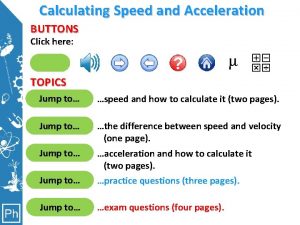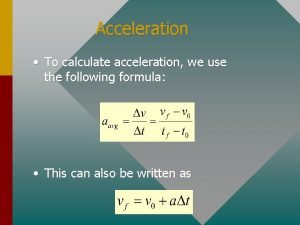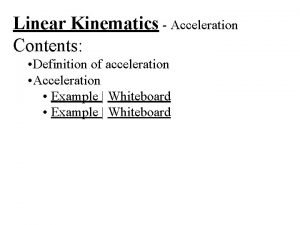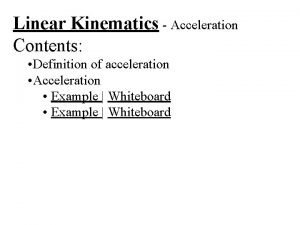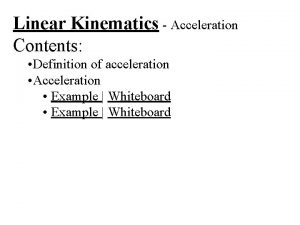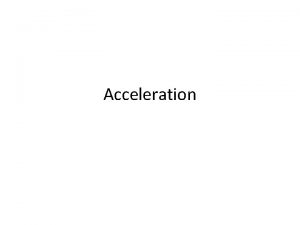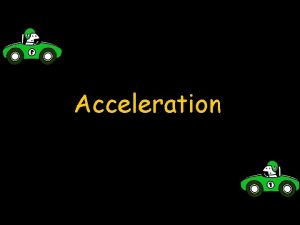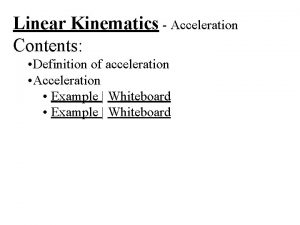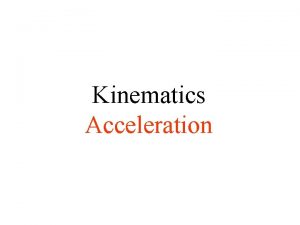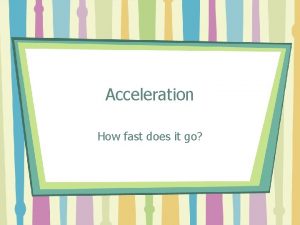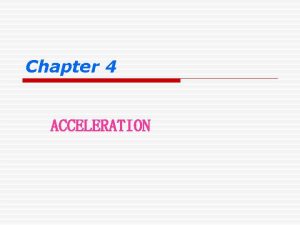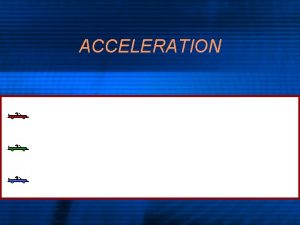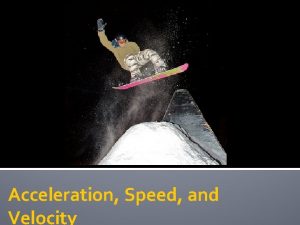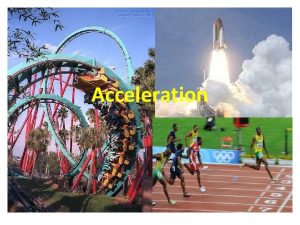Acceleration To calculate acceleration we use the following























- Slides: 23

Acceleration • To calculate acceleration, we use the following formula: • This can also be written as

Example Exercises from Notes • Accelerating Plane 2 can also be • An acceleration of +4. 35 m/s -2. written as +4. 35 m/s/s or +4. 35 m s This means that every second, the velocity changes by +4. 35 m/s

Acceleration § Which one of these accelerations is the largest? • 60 mi/hr-s • 60 mi/hr-min • 60 mi/hr-hr

Ex. Exercises from Notes, cont. • Car Slowing Down • Notice that in computing Δ v, you always subtract final from initial: v-v 0 • Question: An object moving at -25 m/s with an acceleration of +5 m/s/s. What is its velocity after 7 s?

Example 3 (No change in direction): A constant force changes the speed of a car from 8 m/s to 20 m/s in 4 s. What is the average acceleration? + Force t=4 s v 1 = +8 m/s v 2 = +20 m/s Step 1. Draw a rough sketch. Step 2. Choose a positive direction (right). Step 3. Label given info with + and signs. Step 4. Indicate direction of force F.

Example 3 (Continued): acceleration of car? What is average + Force t=4 s v 1 = +8 m/s Step 5. Recall definition of average acceleration. v 2 = +20 m/s

Example 4: A wagon moving east at 20 m/s encounters a very strong head-wind, causing it to change directions. After 5 s, it is traveling west at 5 m/s. What is the average acceleration? (Be careful of signs. ) + v f = -5 m/s E Force v o = +20 m/s Step 1. Draw a rough sketch. Step 2. Choose the eastward direction as positive. Step 3. Label given info with + and signs.

Example 4 (Cont. ): Wagon moving east at m/s encounters a head-wind, causing it to change directions. Five seconds later, it is traveling west at 5 m/s. What is the average acceleration? Choose the eastward direction as positive. Initial velocity, (+) v o = +20 m/s, east Final velocity, v f = -5 m/s, west (-) The change in velocity, Dv = v f - v 0 Dv = (-5 m/s) - (+20 m/s) = -25 m/s 20

+ Example 4: (Continued) v f = -5 m/s aavg = Dv Dt a=-5 m/s 2 E v o = +20 m/s Force Dv = (-5 m/s) - (+20 m/s) = -25 m/s = vf - vo tf - t o a= -25 m/s 5 s Acceleration is directed to left, west (same as F).

+ Signs for Displacement D v f = -25 m/s A v o = +20 m/s C E Force a = - 5 m/s B 2 Time t = 0 at point A. What are the signs (+ or -) of displacement moving from? A to B B to C C to D

+ Signs for Velocity D v f = -25 m/s x=0 A v o = +20 m/s C E Force a = - 5 m/s B 2 What are the signs (+ or -) of velocity at points B, C, and § D? At B, v is zero - no sign § needed. At C , v is positive on way out and negative on the way back. § At D , v is negative , moving to left.

Signs for Acceleration + D v f = -25 m/s Force C A v o = +20 m/s B a = - 5 m/s 2 What are the signs (+ or -) of acceleration at points B, C, D? D , a = -5 m/s, § At B, and C, and negative at all points. § The force is constant and always directed to left, so acceleration does not change.

Distance and Acceleration • A car starting from rest accelerates at 2 m/s 2. Which of the following is true? A. The car covers 2 m of distance every second. B. The car covers 2 m more distance than in the previous second (2 m, then 4 m, then 6 m, etc) C. The car covers more and more distance each second (2 m, then 4 m, then 8 m,

Equations for Constant Acceleration To find the distance an object covers while accelerating, use this equation: (2) Notice that, if a =0 and you start from the origin, this equation becomes more recognizable: 0 0

Eqns for Motion at Constant Acceleration We can combine equations (1) & (2) so as to eliminate t : (3) We now have all the equations we need to solve constant-acceleration problems. (1) (2) (3)

Example 5: A ball 5 m from the bottom of an incline is traveling initially at 8 m/s. Four seconds later, it is traveling down the incline at 2 m/s. How far is it from the bottom at that instant? + d vo vf F -2 m/s t = 4 Careful 8 m/s s vo + v f 8 m/s + (-2 m/s) d = do + t =5 m+ (4 s) 2 2 5 m

(Continued ) + F d vo vf -2 m/s t = 4 8 m/s s 8 m/s + (-2 m/s) d=5 m+ (4 s) 2 5 m d=5 m+ 8 m/s - 2 m/s 2 (4 s) x = 17 m

Use of Initial Position Problems 0 0 0 d 0 in If you choose the origin of your x, y axes at the point of the initial position, you can set d 0 = 0, simplifying these equations. The d o term is very useful for studying problems involving motion of two bodies.

Review of Symbols and Units • Displacement ( x, x o ); meters ( m ) • Velocity ( v, v o ); meters per second ( m/s ) • Acceleration ( a); meters per s • Time ( t ); seconds ( s ) Review sign convention for each symbol 2 ( m/s 2 )

Problem Solving Strategy: § Draw and label sketch of problem. § Set up coordinate system (which way is + and where is the origin) § List givens and state what is to be found. Given: ____, _____ ( d, v, v o , a, t ) Find: equation ____, _____ § Select containing one and not the other of the unknown quantities, and solve for the unknown.

Example 6: A airplane flying initially at 400 ft/s lands on a carrier deck and stops in a distance of 300 ft. What is the acceleration? +400 ft/s v=0 300 +ft F vo X 0 = 0 Step 1. Draw and label sketch. Step 2. Indicate + direction and direction. F

Example: (Cont. ) v=0 +400 ft/s 300 ft + Step 3. List given; find information with signs. List t = ? , even though time was not asked for. F vo X 0 = 0 Given: ft/s v o = +400 v=0 x = +300 ft Find: a = ? ; t = ?

Continued. . . v=0 + x 300 ft +400 ft/s vo F X 0 = 0 Step 4. Select equation that contains a and not t. 2 -vo -(400 a= = ft/s) 2 2 d 0 v 2 =v o 2 0 + 2 a(d -d ) o Initial position and final velocity are zero. a = - 267 2 2(300 ft) ft/s Why is the acceleration Because Force is in a negative? negative direction!
 Centripetal force
Centripetal force Linear and angular quantities
Linear and angular quantities Radial acceleration formula
Radial acceleration formula Linear acceleration vs tangential acceleration
Linear acceleration vs tangential acceleration Tangential acceleration and centripetal acceleration
Tangential acceleration and centripetal acceleration What is acceleration
What is acceleration Calculating acceleration
Calculating acceleration How to calculate acceleration
How to calculate acceleration Use the tabulated half-cell potentials to calculate
Use the tabulated half-cell potentials to calculate Hát kết hợp bộ gõ cơ thể
Hát kết hợp bộ gõ cơ thể Frameset trong html5
Frameset trong html5 Bổ thể
Bổ thể Tỉ lệ cơ thể trẻ em
Tỉ lệ cơ thể trẻ em Voi kéo gỗ như thế nào
Voi kéo gỗ như thế nào Tư thế worm breton là gì
Tư thế worm breton là gì Hát lên người ơi alleluia
Hát lên người ơi alleluia Môn thể thao bắt đầu bằng chữ đua
Môn thể thao bắt đầu bằng chữ đua Thế nào là hệ số cao nhất
Thế nào là hệ số cao nhất Các châu lục và đại dương trên thế giới
Các châu lục và đại dương trên thế giới Công thức tính độ biến thiên đông lượng
Công thức tính độ biến thiên đông lượng Trời xanh đây là của chúng ta thể thơ
Trời xanh đây là của chúng ta thể thơ Cách giải mật thư tọa độ
Cách giải mật thư tọa độ Làm thế nào để 102-1=99
Làm thế nào để 102-1=99 Phản ứng thế ankan
Phản ứng thế ankan






